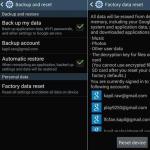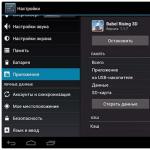The sizes of media files on devices are constantly increasing over time, and even 64 or 128 GB of built-in memory on a phone is not always enough. When your Android is down to the last bytes of memory, it is useful to delete unnecessary files and unnecessary data backups.
If you want to know what cached data is and how to clear the cache on Android (in the browser, in the application), then this article will undoubtedly help you. It describes a number of ways in which any user can easily clear cached data on their Android device.
Cached data is files, images, and other types of media that are stored on devices while you use apps or visit websites. Cache data has a special purpose and is backed up locally by apps in your device's memory.
Therefore, every time you load any application, the cache provides faster access to the information you need. For example, a website page will load faster the next time you visit it because it has been cached.
When is it necessary to clear the cache on Android?
If there is little free memory left on the device; if any applications experience glitches; if the device, in your opinion, has become slower. In all these cases, you need to get rid of the cached data.
How to clear the cache on Android manually, 4 ways
By clearing the cache, you delete temporary files in the cache, but do not delete other application data, such as logins, settings, game saves, downloaded photos, conversations. So if you clear the cache of the Gallery or Camera app on your Android phone, you won't lose any of your photos.
Deleting cache data on Android using the Settings application
You can delete all cached data at once using the Settings app on your Android.
– Go to Settings and select the section Memory. There you can see how much memory is occupied by application data and multimedia files.
– Click on a section Cache data, which also displays the amount of memory used by cached data.


Back 1 from 3 Further
Selective cache clearing on Android, for individual applications
Every Android smartphone has an application manager, which you can access through the settings menu. Here you can see every app installed on your phone or tablet. And this is convenient to clear the cache of an individual application.
If deleting cached data from all apps at once doesn't feel right to you, try clearing the cache for each individual app.
– Go to Settings and click section Applications.
– Select the desired application for which you are going to clear the cache.
- On page of the selected application go to the section Memory.
– Now you can delete the cached data of this application by clicking on the highlighted button Clear cache.
You can also clear data if the application is not working correctly. Clearing app data is a little more drastic. You clear the cache, but you also clear all settings for that application. When you clear data, you start this app from scratch and it will behave the same as the first time you installed it.
If you clear your app data on, say, Facebook, you'll need to sign in again. If you clear the data of a game you were playing, everything will go back to normal as if you never played.




So, clearing your app's cache when your phone is slow or memory is full may seem like the best option in the short term, but it may have consequences in the long term, so you shouldn't do it too often.
Using third-party apps to clear cache on Android
Special “cleaner” applications for Android do a good job of finding unnecessary files or cache data and deleting them. Many such applications are available on the Play Store.
A good application for not very powerful smartphones, it uses very little power and does its job perfectly.

Another good app.

Clearing the cache on Android using Recovery mode
Note: This is a procedure for advanced users, as there is a possibility of damaging the device. We give the recommendations below only to those who already have experience restoring or updating the OS, as well as to those who have read in detail on the Internet the procedure for carrying out this procedure for their specific device.
If your device begins to work slowly, or you begin to notice failures during its operation, you can try clearing the cache partition in the system using a special option in the mode Recovery.
– Turn off your device.
– This method of clearing system cache data may differ for different device manufacturers. Therefore, we recommend that you first find the necessary information on the Internet. Boot your smartphone into recovery mode.
To do this, you need to press a certain combination of buttons, for example, the button Power+ decrease key Volume, or button Power+ both adjustment keys Volume.
– The touch screen may not work, so you may have to use the adjustment keys to navigate Volume.
– Find a mode Recovery and select it by clicking the button Power.
– Find the option Clearing the cache partition and press the button Power.
– After deleting the system cache data, immediately reboot the device.
The cache in a phone or tablet based on Android OS is an intermediate buffer with quick access in which this or that information is stored. In this case, we are talking about the data that applications use. The cache is also necessary for faster launch and access to the application. But in some cases, the cache size increases so much that the system may slow down, and due to lack of space, it will not be possible to install new applications. Therefore, today we will talk about how to actually clear this cache. Please note that the manufacturer of the device does not matter, whether it is Samsung, Sony, Lenovo, LG, HTC, Xiaomi, etc., since the algorithm of actions will be the same. The difference can only be in the arrangement of elements depending on the type of firmware.
Clearing the cache: everything at once
So, the easiest way to clear the cache. Go to the device settings.


We see all available memory. There is an item here called "Cache Data" which specifies the amount of memory used for the cache. In our case, this is 147 MB - far from a record.

We click on this item, after which an additional window appears that asks us whether we need to clear the cache? Click on the OK button to confirm the action.

The cache has been cleared.
Clear cache for one application
You can clear the cache for each individual application. To do this, you need to go to the settings again, only this time select the “Applications” section.

Here you will see a list of applications, including third-party ones. Find the application you need and tap on it.

On the application page we see the “Cache” subsection. The cache size will also be indicated here. Click on the “Clear cache” button, after which it will be automatically deleted.

Clear cache using an app
The cache can be cleared using the application. To do this, go to Google Play Market and download, for example, the Clean Master application.

After installation, launch it. Click on the “Trash” button so that the system finds all unnecessary files.

The calculation is completed and we see 441 MB of data that can be deleted, including the application cache. Click on the “Clear” button, after which the system deletes everything itself.

If you have questions about the article, you can ask them using the comments.
Hi all. Today is a short article - we’ll figure out how to clear the browser cache on Android, using Chrome (Google Chrome) as an example.
Let's not waste time, let's get down to business. Open your Google Chrome browser or any other, all steps are similar. For Chrom, there will be three vertical dots in the upper right corner:
click on them and, in the menu that opens, look for the “History” item:


A window will open where you need to select, firstly, a range, that is, for how long to delete the cache (point 1 on the screen), mark what to delete (2) - I prefer not to delete cookies, so as not to log in again on each site, but you Decide for yourself, they don’t take up much space, so I’ll leave them:

You can also mark it as in my screenshot.
and further, do not rush to click “Delete data”, first, I strongly advise you to look at the adjacent tab - “Advanced” (3) to make sure that the “Sites with saved passwords” item is not checked - if, of course, there are any at all, if you save passwords in your browser on Android, then do not forget to uncheck this item:

You noted what you wanted, and now click “Delete data.” And after some time, depending on the degree of accumulated garbage, all cache and other garbage will be cleared.
This is the first option.
There is another cleaning option, using special. applications such as CCleaner, Clean Master and the like. There you can clear the cache and other temporary files for all applications at once, in one fell swoop. We will discuss this method in more detail in one of the following articles.
And finally, one more way, through the phone settings. Go to the “Settings” menu -> “Applications” -> “Chrome” (or wherever you want to clear garbage) - look for the “Clear cache” item and click on it ( IMPORTANT!!! Do not confuse with the Erase data item - because in this case, you will lose all your saved bookmarks, passwords and other data ). Screen:

That's all for today.
Any questions left - ask in the comments!
See you soon!
Many smartphone owners Have you heard the phrase “if you want your gadget to work faster, clear the cache.” The advice is absolutely correct, but not everyone understands how such a procedure is carried out and what it is all about. Therefore, first, let’s figure out what the cache is in an Android phone and why clear it.
What is cache on a phone?
Will be useful
Cache is a specially allocated area of system memory used to store certain information that is needed by installed applications. The main goal of this section is to speed up the operation of the smartphone.
For example, graphic object viewing programs save thumbnails there so as not to re-load the processor by recalculating the image. Web browsers store layouts of the most frequently visited pages to prevent them from constantly being downloaded. and reduce traffic and wait times.
Why do you need to clear the cache?
The only one The problem with cache usage is that it keeps growing. Ultimately, this will lead to a lack of memory for running basic applications, which will negatively affect the performance of the gadget.
As a result, it turns out that the cache performs functions completely opposite to those for which it is intended: slows down the device instead of speeding up all active processes.
There is a simple way out of this situation - clearing the Android OS cache. This fairly simple operation is performed using various methods, which are discussed in detail below.
The question is often asked “what happens if you clear the cache on Android?” This definitely won't do any harm.
note
The procedure is absolutely safe if performed in accordance with certain technology. But the size of the freed up memory and the increase in the speed of the mobile device (especially if the memory was full of graphic files and the results of online video viewing) will be noticeable and will please the owner of the smartphone.
The only warning: Clearing the cache of running programs may cause them to malfunction. Therefore, before carrying out such an operation, it is recommended to first close all active applications.
Types of cache
The Android operating system divides cache memory into three main groups:
- Dalvik. Internal system area allocated for the memory of the virtual machine - the Dalvik register. User access to this section is closed and not recommended: Deleting data can cause a serious malfunction of the gadget.
- System cache. Used to run programs and applications that ensure the functioning of the operating system. We are also not allowed entry here, since unprofessional interference with the operation of the OS will lead to unpredictable consequences.
- The user's application cache is exactly that section of internal memory that can and should be freed periodically. All recommendations on the topic “How to clear the cache on Android” relate specifically to the area of user programs.
Now, having received a general idea of the subject, we move directly to the procedures for clearing the cache on Android.
Popular cleaning methods
Exists There are three main options for clearing the cache on Android:
- using system capabilities;
- using third party applications;
- using the recovery mode functions ().
The first two methods provide the ability to delete data from all user applications at the same time, as well as a custom approach to the process: you can clear the cache on your Android phone for only one or several programs, without touching the rest.
System cleaning in older versions of Android
For operating systems up to version 5 inclusive, the group cleaning method is not available, you will have to perform the operation separately for each application. The sequence of actions is as follows:

Cleaning in new OS versions
The algorithm for clearing the cache on Android for Samsung Galaxy and other modern phone models using OS version 6 and higher is somewhat different. In this case, there is no Clear Cache button in each application section. You need to activate the “Storage” menu item, and start the procedure in the window that opens.



Will be useful
In most new OS modifications, it is possible to clear the entire user cache at once. To do this, follow the menu chain “Settings” -> “Memory” -> “Cache Data” and in response to the request “Clear?” Confirm the action by clicking “OK”.
Using special applications
There are many utilities whose set of functions includes clearing the cache: Cache Cleaner, Clean Master, CCleaner and others. Most of them are free and available for download in the standard Google Store. Let's look at how to clear the cache on Android using each of these programs.
First, you need to download the selected application from the store and on your smartphone or tablet. Then run the utility and perform the following steps:
- . Click on the trash can icon located in the upper right corner and confirm your choice by clicking “OK”. A useful feature of this program is the ability to set a reminder: the notification panel will constantly display information about the current cache size. To carry out cleaning, you don’t even need to launch the application, just tap on the trash can icon itself.
- . Select the “Trash” section, wait until the calculation of the occupied space is completed and activate the “Clean up garbage” button.
- . Click on the “Analysis” button located at the bottom left of the screen and wait for the calculation to complete. Check the box to the right of “Cache” and tap “Clear” (bottom right of the screen).




What does it mean to clear the cache on your phone? This question is often asked by smartphone users. Each application is configured in such a way as to minimize the load on the operating system and at the same time work quickly. To do this, some files are installed on the memory card. Do I need to periodically clear the cache? Everyone's personal business. However, you must understand that when the storage is full, the device may malfunction. Also, when installing new applications, you may run out of memory.
In some phones, the manufacturer has already provided a way to clear the cache in the settings. However, there are also models in which this cannot be done quickly. Let's look at a few ways.
On the phone through the settings menu? In order to speed up the operation of the device, you will need to delete mobile browser files. The user must go to the WAP section through the main menu. In it, find the “Settings” item and activate the “Clear cache memory” command. After this, it is recommended to go back and select the “Delete cookies” line, which can also slow down the operation of the gadget.
Opera
How can I clear the cache on my phone if the fourth or fifth version of the Opera browser is installed? For this procedure you need to enter the settings. Then find the Settings Privacy tab. In it, select the Delete history and Delete cookies commands.
If Opera mini is installed on your phone, then you need to use a different method. From the “Tools” tab, go to “Options”. In it, find the “Clear cookies” command and activate it. When finished, reboot the device.

HTC Sensation
How to clear cache on HTC Sensation? The above methods are not suitable for this model. The user needs to perform the following algorithm of actions. Go to the menu through the main screen. In it, select the “Memory” tab. After which a list will open, in which there will be an item “Internal storage”. Here activate the “Free up more space” link. Next, the user will be presented with a list of applications where it is necessary to clear the cache. Having made your choice, confirm with the “Next” button. The system will then execute the programmed command.
Google Play app
Nowadays, most smartphone owners often use Google Play. For this reason, you need to know how to clear the cache of not only the application, but also the download manager. These actions are performed in the settings menu. In it, the “Applications” item opens and the “Application Management” tab is selected. To display all programs installed on the phone, the user must click the "All" button. In the list that opens, check the box next to Google Play and activate the commands: the first is “Erase data”, the second is “Delete cache”. This algorithm is also used to clean download manager files.
How to clear the cache on your phone using Clean Master?
To clear the cache, advanced users recommend using the mobile version of the popular CCleaner program. The application has a wide range of options. In addition to clearing memory, you can close all applications running to monitor battery consumption, etc.
How to use the application?
- Install on your smartphone.
- Launch the utility.
- Enter the “Garbage” item.
- Activate the "Clear" command.

Cache Clear - program for clearing cache memory
How to clear the cache on your phone using the Cache Clear program?
- Download the application to your device.
- Open the program.
- To quickly clear, select the “All” command.
- Confirm action.
If you need to clear the cache in only a few applications, then instead of the “All” command, click on the “Cache” button. In the list that opens on the screen, select specific programs and activate the “Clean” link.
Cache Clear has an automatic option - “Auto Cleanup”. It allows you to program the time interval after which the device will clear the cache without user intervention.




